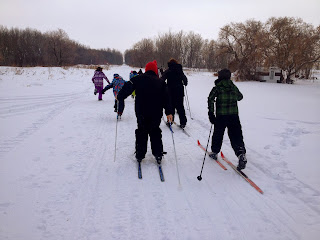“Winter is the time for comfort, for good food and warmth, for the touch of a friendly hand and for a talk beside the fire: it is the time for home.”
-Poet Edith Sitwell
Black and white seemed fitting for these January photos. I believe we got outside once, maybe twice this month. Instead, we have found ourselves cozy and warm, protected by the century old walls of our daytime home. Below you will see photos of our Manitoba Animals in Winter project. The first step was to study the appearance of the animal. We looked at many pictures, watched videos, and read descriptions of the animal's appearance. We sketched the animal, as Myles is doing with his Jackrabbit here:Animal Projects
We also sculpted models of our animals. We started with a ball of Model Magic clay and puuuuuulllllled out the head, puuuullled out legs, pulled out a tail, ears, wings...
We did a lot of reading to learn about the habitat of our animal. And after all this reading about homes, one of us (I think it was you, Sam) decided their little animal needed a home. And now that one of the clay animals had a home, a few more needed nests or dens to survive the cold nights left alone at the school. Within a couple of days we were collecting shoe boxes and all making elaborate dioramas that represented a winter habitat.
 |
| Mink leaving his den with a mouse in his mouth |
 |
| The Wolf looks around for a rabbit. |
Seeing these projects evolve has been exciting for us all.
Today we were very fortunate to share our learning with Matthew's grandpa, who worked for Manitoba Conservation for over 40 years! Mr. "Matt's Grandpa" Gillespie is a real expert who taught us a lot of very interesting things about how animals adapt for winter. Mr Gillespie talked about all the animals we have been studying (and more!) and even brought in his animal calls. We also got to see wolf, mink, and muskrat pelts, learning so much from being able to closely examine them.
Here we are with Mr. Gillespie looking at the difference between bobcat claws and wolf claws. These two animals have very different claws for a good reason. Wolves have claws that will give them traction on the snow and ice; their claws and paws are designed to dig for prey. Bobcats on the other hand, use their claws to catch their prey.
Map Work
When we started taking about the animals around us, the creatures we have seen in the bush, we started to talk about where we live. And when we started to talk about where we live, we started to look at maps. And when we started to look at maps...
We drew all seven continents on a long piece of paper and traced over the pencil lines with thick oil pastel to define the land. We waited for the pre-school children to paint the water, as it was an opportunity for the K-3s to teach the colour blue to our younger friends. We finished it off with the magic touch: salt, to help us remember the oceans are salt water and to give our map a shimmery glow.
 |
| working together |
 |
| this one calls out for colour! |
Here we are adding the names of the continents and oceans to the map. Once we got looking at and talking about maps, we certainly had to look at and talk about GLOBES! Yesterday morning I walked towards these two, and had to turn back and grab my camera. Look at how the light beautifully shines on Matt and Myles as they make their own globe out of plaster strips and a balloon.
Mrs Hadfield (my mom) was in this week to help with knitting club, and she enjoyed it so much, she helped us with our globes afterwards.
Keeping with Routine
I love this picture of Tom, he is so into the letter H. He has set himself up with an encyclopedia, an ipad, and he is going to find THE best words beginning with the H sound.
Sam and Autumn are playing a game called, Race to 100. Here they are collecting and regrouping units into tens.
Finding letters at the stamping table. The answer to, "Why do you come home with ink on your arms and hands?"
Good-bye January, and welcome
With open arms,
February




















